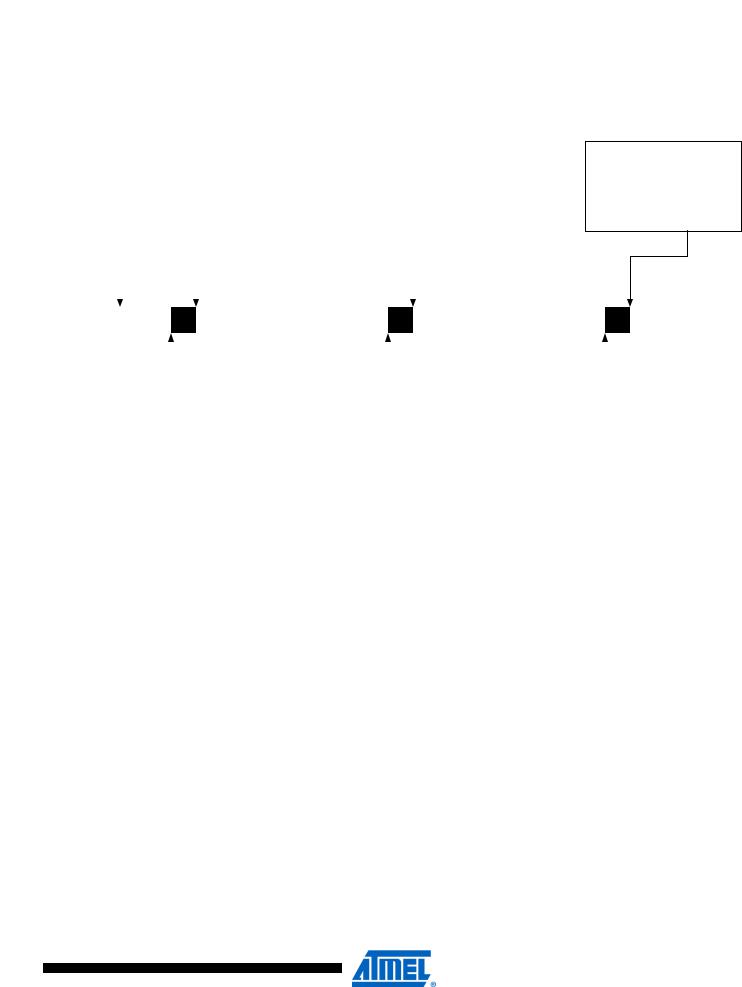
- •Features
- •Overview
- •Block Diagram
- •Pin Descriptions
- •Port A (PA7..PA0)
- •Port B (PB7..PB0)
- •Port C (PC7..PC0)
- •Port D (PD7..PD0)
- •Port E (PE7..PE0)
- •Port F (PF7..PF0)
- •Port G (PG4..PG0)
- •RESET
- •XTAL1
- •XTAL2
- •AVCC
- •AREF
- •Resources
- •Data Retention
- •Capacitive touch sensing
- •AVR CPU Core
- •Introduction
- •Status Register
- •Stack Pointer
- •I/O Memory
- •Overview
- •Timing
- •Using all Locations of External Memory Smaller than 64 Kbyte
- •Clock Systems and their Distribution
- •CPU Clock – clkCPU
- •I/O Clock – clkI/O
- •Flash Clock – clkFLASH
- •ADC Clock – clkADC
- •Clock Sources
- •Crystal Oscillator
- •External Clock
- •Idle Mode
- •Power-down Mode
- •Power-save Mode
- •Standby Mode
- •Analog Comparator
- •Brown-out Detector
- •Watchdog Timer
- •Port Pins
- •Resetting the AVR
- •Reset Sources
- •Power-on Reset
- •External Reset
- •Watchdog Reset
- •Watchdog Timer
- •Timed Sequences for Changing the Configuration of the Watchdog Timer
- •Safety Level 0
- •Safety Level 1
- •Safety Level 2
- •Interrupts
- •I/O Ports
- •Introduction
- •Configuring the Pin
- •Reading the Pin Value
- •Unconnected pins
- •Alternate Port Functions
- •Register Description for I/O Ports
- •8-bit Timer/Counter0 with PWM and Asynchronous Operation
- •Overview
- •Registers
- •Definitions
- •Counter Unit
- •Normal Mode
- •Fast PWM Mode
- •8-bit Timer/Counter Register Description
- •Overview
- •Registers
- •Definitions
- •Compatibility
- •Counter Unit
- •Input Capture Unit
- •Noise Canceler
- •Force Output Compare
- •Normal Mode
- •Fast PWM Mode
- •16-bit Timer/Counter Register Description
- •Internal Clock Source
- •Prescaler Reset
- •External Clock Source
- •8-bit Timer/Counter2 with PWM
- •Overview
- •Registers
- •Definitions
- •Counter Unit
- •Normal Mode
- •Fast PWM Mode
- •8-bit Timer/Counter Register Description
- •Output Compare Modulator (OCM1C2)
- •Overview
- •Description
- •Timing Example
- •Slave Mode
- •Master Mode
- •Data Modes
- •USART
- •Dual USART
- •Overview
- •AVR USART vs. AVR UART – Compatibility
- •Clock Generation
- •External Clock
- •Frame Formats
- •Parity Bit Calculation
- •Parity Generator
- •Receiver Error Flags
- •Parity Checker
- •Disabling the Receiver
- •Using MPCM
- •Features
- •TWI Terminology
- •Transferring Bits
- •Address Packet Format
- •Data Packet Format
- •Overview of the TWI Module
- •Scl and SDA Pins
- •Bus Interface Unit
- •Address Match Unit
- •Control Unit
- •Using the TWI
- •Master Receiver Mode
- •Slave Receiver Mode
- •Miscellaneous States
- •Analog Comparator
- •Analog to Digital Converter
- •Features
- •Operation
- •Changing Channel or Reference Selection
- •ADC Input Channels
- •Analog Input Circuitry
- •Features
- •Overview
- •TAP Controller
- •PRIVATE0; $8
- •PRIVATE1; $9
- •PRIVATE2; $A
- •PRIVATE3; $B
- •Bibliography
- •Features
- •System Overview
- •Data Registers
- •Bypass Register
- •Reset Register
- •EXTEST; $0
- •IDCODE; $1
- •AVR_RESET; $C
- •BYPASS; $F
- •Scanning the ADC
- •ATmega128 Boundary-scan Order
- •Application Section
- •Programming Time for Flash when Using SPM
- •Simple Assembly Code Example for a Boot Loader
- •Fuse Bits
- •Latching of Fuses
- •Signature Bytes
- •Calibration Byte
- •Signal Names
- •Chip Erase
- •Reading the Flash
- •Reading the EEPROM
- •Data Polling Flash
- •Data Polling EEPROM
- •AVR_RESET ($C)
- •PROG_ENABLE ($4)
- •Data Registers
- •Reset Register
- •Programming Enable Register
- •Programming Command Register
- •Virtual Flash Page Read Register
- •Performing Chip Erase
- •Reading the Flash
- •Reading the EEPROM
- •Electrical Characteristics
- •Absolute Maximum Ratings*
- •DC Characteristics
- •Speed Grades
- •External Clock Drive Waveforms
- •External Clock Drive
- •Two-wire Serial Interface Characteristics
- •ADC Characteristics
- •External Data Memory Timing
- •Idle Supply Current
- •Pin Pull-up
- •Pin Driver Strength
- •Register Summary
- •Instruction Set Summary
- •Ordering Information
- •Packaging Information
- •Errata
- •ATmega128 Rev. F to M

 ATmega128
ATmega128
TWI Data Register –
TWDR
TWI (Slave) Address
Register – TWAR
Using the TWI
Bit |
7 |
6 |
5 |
4 |
3 |
2 |
1 |
0 |
|
|
TWD7 |
TWD6 |
TWD5 |
TWD4 |
TWD3 |
TWD2 |
TWD1 |
TWD0 |
TWDR |
|
|
|
|
|
|
|
|
|
|
Read/Write |
R/W |
R/W |
R/W |
R/W |
R/W |
R/W |
R/W |
R/W |
|
Initial Value |
1 |
1 |
1 |
1 |
1 |
1 |
1 |
1 |
|
In Transmit mode, TWDR contains the next byte to be transmitted. In receive mode, the TWDR contains the last byte received. It is writable while the TWI is not in the process of shifting a byte. This occurs when the TWI interrupt flag (TWINT) is set by hardware. Note that the Data Register cannot be initialized by the user before the first interrupt occurs. The data in TWDR remains stable as long as TWINT is set. While data is shifted out, data on the bus is simultaneously shifted in. TWDR always contains the last byte present on the bus, except after a wake up from a sleep mode by the TWI interrupt. In this case, the contents of TWDR is undefined. In the case of a lost bus arbitration, no data is lost in the transition from Master to Slave. Handling of the ACK bit is controlled automatically by the TWI logic, the CPU cannot access the ACK bit directly.
• Bits 7..0 – TWD: TWI Data Register
These eight bits constitute the next data byte to be transmitted, or the latest data byte received on the Two-wire Serial Bus.
Bit |
7 |
6 |
5 |
4 |
3 |
2 |
1 |
0 |
|
|
TWA6 |
TWA5 |
TWA4 |
TWA3 |
TWA2 |
TWA1 |
TWA0 |
TWGCE |
TWAR |
|
|
|
|
|
|
|
|
|
|
Read/Write |
R/W |
R/W |
R/W |
R/W |
R/W |
R/W |
R/W |
R/W |
|
Initial Value |
1 |
1 |
1 |
1 |
1 |
1 |
1 |
0 |
|
The TWAR should be loaded with the 7-bit slave address (in the seven most significant bits of TWAR) to which the TWI will respond when programmed as a slave transmitter or receiver, and not needed in the master modes. In multimaster systems, TWAR must be set in masters which can be addressed as slaves by other masters.
The LSB of TWAR is used to enable recognition of the general call address ($00). There is an associated address comparator that looks for the slave address (or general call address if enabled) in the received serial address. If a match is found, an interrupt request is generated.
• Bits 7..1 – TWA: TWI (Slave) Address Register
These seven bits constitute the slave address of the TWI unit.
• Bit 0 – TWGCE: TWI General Call Recognition Enable Bit
If set, this bit enables the recognition of a General Call given over the Two-wire Serial Bus.
The AVR TWI is byte-oriented and interrupt based. Interrupts are issued after all bus events, like reception of a byte or transmission of a START condition. Because the TWI is interrupt-based, the application software is free to carry on other operations during a TWI byte transfer. Note that the TWI Interrupt Enable (TWIE) bit in TWCR together with the Global Interrupt Enable bit in SREG allow the application to decide whether or not assertion of the TWINT flag should generate an interrupt request. If the TWIE bit is cleared, the application must poll the TWINT flag in order to detect actions on the TWI bus.
When the TWINT flag is asserted, the TWI has finished an operation and awaits application response. In this case, the TWI Status Register (TWSR) contains a value indicating the current state of the TWI bus. The application software can then decide how the TWI should behave in the next TWI bus cycle by manipulating the TWCR and TWDR Registers.
Figure 95 is a simple example of how the application can interface to the TWI hardware. In this example, a master wishes to transmit a single data byte to a slave. This description is quite
207
2467X–AVR–06/11

 ATmega128
ATmega128
abstract, a more detailed explanation follows later in this section. A simple code example implementing the desired behavior is also presented.
Figure 95. Interfacing the Application to the TWI in a Typical Transmission
Application |
Action |
1. Application |
|
3. Check TWSR to see if START |
|
5. Check TWSR to see if SLA+W |
||||||
writes to TWCR |
|
was sent. Application loads |
|
was sent and ACK received. |
||||||||
|
|
|
|
|||||||||
|
|
to initiate |
|
SLA+W into TWDR, and loads |
|
Application loads data into TWDR, |
||||||
|
|
transmission of |
|
appropriate control signals into |
|
and loads appropriate control signals |
||||||
|
|
START |
|
TWCR, making sure that TWINT |
|
into TWCR, making sure that TWINT |
||||||
|
|
|
|
|
|
|
is written to one, and TWSTA is |
|
is written to one. |
|||
|
|
|
|
|
|
|
written to zero. |
|
|
|
|
|
|
|
|
|
|
|
|
|
|
|
|
|
|
|
|
|
|
|
|
|
|
|
|
|
|
|
7. Check TWSR to see if data was sent and ACK received. Application loads appropriate control signals to send STOP into TWCR, making sure that TWINT is written to one
TWI bus |
START |
|
SLA+W |
A |
|
Data |
A |
|
STOP |
|
|
|
|
|
|
|
|
|
|
|
|
|
|
|
|
|
|
|
|
|
|
|
|
Indicates |
|
|
|
|
|
|
|
|
|
|
|
|
|
|
|
|
2. TWINT set. |
|
4. TWINT set. |
|
6. TWINT set. |
|
|
|||||||
|
|
|
|
|
TWINT set |
|||||||||
|
Status code indicates |
|
Status code indicates |
|
Status code indicates |
|
|
|||||||
TWI |
|
|
|
|
|
|||||||||
START condition sent |
|
SLA+W sendt, ACK |
|
data sent, ACK received |
|
|
|
|||||||
Hardware |
|
|
|
|
|
|||||||||
|
|
|
|
received |
|
|
|
|
|
|
|
|||
Action |
|
|
|
|
|
|
|
|
|
|
|
|
|
|
1.The first step in a TWI transmission is to transmit a START condition. This is done by writing a specific value into TWCR, instructing the TWI hardware to transmit a START condition. Which value to write is described later on. However, it is important that the TWINT bit is set in the value written. Writing a one to TWINT clears the flag. The TWI will not start any operation as long as the TWINT bit in TWCR is set. Immediately after the application has cleared TWINT, the TWI will initiate transmission of the START condition.
2.When the START condition has been transmitted, the TWINT flag in TWCR is set, and TWSR is updated with a status code indicating that the START condition has successfully been sent.
3.The application software should now examine the value of TWSR, to make sure that the START condition was successfully transmitted. If TWSR indicates otherwise, the application software might take some special action, like calling an error routine. Assuming that the status code is as expected, the application must load SLA+W into TWDR. Remember that TWDR is used both for address and data. After TWDR has been loaded with the desired SLA+W, a specific value must be written to TWCR, instructing the TWI hardware to transmit the SLA+W present in TWDR. Which value to write is described later on. However, it is important that the TWINT bit is set in the value written. Writing a one to TWINT clears the flag. The TWI will not start any operation as long as the TWINT bit in TWCR is set. Immediately after the application has cleared TWINT, the TWI will initiate transmission of the address packet.
4.When the address packet has been transmitted, the TWINT flag in TWCR is set, and TWSR is updated with a status code indicating that the address packet has successfully been sent. The status code will also reflect whether a slave acknowledged the packet or not.
5.The application software should now examine the value of TWSR, to make sure that the address packet was successfully transmitted, and that the value of the ACK bit was as expected. If TWSR indicates otherwise, the application software might take some special action, like calling an error routine. Assuming that the status code is as expected, the
208
2467X–AVR–06/11

 ATmega128
ATmega128
application must load a data packet into TWDR. Subsequently, a specific value must be written to TWCR, instructing the TWI hardware to transmit the data packet present in TWDR. Which value to write is described later on. However, it is important that the TWINT bit is set in the value written. Writing a one to TWINT clears the flag. The TWI will not start any operation as long as the TWINT bit in TWCR is set. Immediately after the application has cleared TWINT, the TWI will initiate transmission of the data packet.
6.When the data packet has been transmitted, the TWINT flag in TWCR is set, and TWSR is updated with a status code indicating that the data packet has successfully been sent. The status code will also reflect whether a slave acknowledged the packet or not.
7.The application software should now examine the value of TWSR, to make sure that the data packet was successfully transmitted, and that the value of the ACK bit was as expected. If TWSR indicates otherwise, the application software might take some special action, like calling an error routine. Assuming that the status code is as expected, the application must write a specific value to TWCR, instructing the TWI hardware to transmit a STOP condition. Which value to write is described later on. However, it is important that the TWINT bit is set in the value written. Writing a one to TWINT clears the flag. The TWI will not start any operation as long as the TWINT bit in TWCR is set. Immediately after the application has cleared TWINT, the TWI will initiate transmission of the STOP condition. Note that TWINT is NOT set after a STOP condition has been sent.
209
2467X–AVR–06/11

 ATmega128
ATmega128
Even though this example is simple, it shows the principles involved in all TWI transmissions. These can be summarized as follows:
•When the TWI has finished an operation and expects application response, the TWINT flag is set. The SCL line is pulled low until TWINT is cleared.
•When the TWINT flag is set, the user must update all TWI Registers with the value relevant for the next TWI bus cycle. As an example, TWDR must be loaded with the value to be transmitted in the next bus cycle.
•After all TWI Register updates and other pending application software tasks have been completed, TWCR is written. When writing TWCR, the TWINT bit should be set. Writing a one to TWINT clears the flag. The TWI will then commence executing whatever operation was specified by the TWCR setting.
In the following an assembly and C implementation of the example is given. Note that the code below assumes that several definitions have been made for example by using include-files.
210
2467X–AVR–06/11

 ATmega128
ATmega128
|
Assembly Code Example |
C Example |
Comments |
||
|
|
|
|
|
|
1 |
|
ldi |
r16, |
TWCR = (1<<TWINT)|(1<<TWSTA)| |
|
|
|
(1<<TWINT)|(1<<TWSTA)| |
(1<<TWEN) |
Send START condition |
|
|
|
|
|
||
|
|
|
(1<<TWEN) |
|
|
|
|
|
|
|
|
|
|
out |
TWCR, r16 |
|
|
2 |
|
wait1: |
while (!(TWCR & (1<<TWINT))) |
|
|
|
|
in |
r16,TWCR |
; |
Wait for TWINT flag set. This indicates that the |
|
|
sbrs |
r16,TWINT |
|
START condition has been transmitted |
|
|
|
|
||
|
|
rjmp |
wait1 |
|
|
3 |
|
in |
r16,TWSR |
if ((TWSR & 0xF8) != START) |
Check value of TWI Status Register. Mask |
|
|
andi |
r16, 0xF8 |
ERROR(); |
|
|
|
prescaler bits. If status different from START |
|||
|
|
cpi |
r16, START |
|
|
|
|
|
go to ERROR |
||
|
|
|
|
|
|
|
|
brne |
ERROR |
|
|
|
|
ldi |
r16, SLA_W |
TWDR = SLA_W; |
|
|
|
out |
TWDR, r16 |
TWCR = (1<<TWINT) | |
Load SLA_W into TWDR Register. Clear |
|
|
ldi |
r16, (1<<TWINT) | |
(1<<TWEN); |
TWINT bit in TWCR to start transmission of |
|
|
(1<<TWEN) |
|
address |
|
|
|
|
|
||
|
|
out |
TWCR, r16 |
|
|
4 |
|
wait2: |
while (!(TWCR & (1<<TWINT))) |
Wait for TWINT flag set. This indicates that the |
|
|
|
in |
r16,TWCR |
; |
|
|
|
SLA+W has been transmitted, and |
|||
|
|
sbrs |
r16,TWINT |
|
|
|
|
|
ACK/NACK has been received. |
||
|
|
|
|
|
|
|
|
rjmp |
wait2 |
|
|
5 |
|
in |
r16,TWSR |
if ((TWSR & 0xF8) != |
Check value of TWI Status Register. Mask |
|
|
andi |
r16, 0xF8 |
MT_SLA_ACK) |
|
|
|
|
prescaler bits. If status different from |
||
|
|
cpi |
r16, MT_SLA_ACK |
ERROR(); |
|
|
|
MT_SLA_ACK go to ERROR |
|||
|
|
|
|||
|
|
|
|
|
|
|
|
brne |
ERROR |
|
|
|
|
ldi |
r16, DATA |
TWDR = DATA; |
|
|
|
out |
TWDR, r16 |
TWCR = (1<<TWINT) | |
Load DATA into TWDR Register. Clear TWINT |
|
|
ldi |
r16, (1<<TWINT) | |
(1<<TWEN); |
|
|
|
bit in TWCR to start transmission of data |
|||
|
|
|
|||
|
|
(1<<TWEN) |
|
||
|
|
|
|
||
|
|
out |
TWCR, r16 |
|
|
6 |
|
wait3: |
while (!(TWCR & (1<<TWINT))) |
Wait for TWINT flag set. This indicates that the |
|
|
|
in |
r16,TWCR |
; |
|
|
|
DATA has been transmitted, and ACK/NACK |
|||
|
|
sbrs |
r16,TWINT |
|
|
|
|
|
has been received. |
||
|
|
|
|
|
|
|
|
rjmp |
wait3 |
|
|
7 |
|
in |
r16,TWSR |
if ((TWSR & 0xF8) != |
Check value of TWI Status Register. Mask |
|
|
andi |
r16, 0xF8 |
MT_DATA_ACK) |
|
|
|
|
prescaler bits. If status different from |
||
|
|
cpi |
r16, MT_DATA_ACK |
ERROR(); |
|
|
|
MT_DATA_ACK go to ERROR |
|||
|
|
|
|||
|
|
|
|
|
|
|
|
brne |
ERROR |
|
|
|
|
ldi |
r16, |
TWCR = (1<<TWINT)|(1<<TWEN)| |
|
|
|
(1<<TWINT)|(1<<TWEN)| |
(1<<TWSTO); |
Transmit STOP condition |
|
|
|
|
|
||
|
|
|
(1<<TWSTO) |
|
|
|
|
|
|
|
|
|
|
out |
TWCR, r16 |
|
|
Note: |
For I/O registers located in extended I/O map, “IN”, “OUT”, “SBIS”, “SBIC”, “CBI”, and “SBI” instructions must be replaced with |
||||
|
|
instructions that allow access to extended I/O. Typically “LDS” and “STS” combined with “SBRS”, “SBRC”, “SBR”, and “CBR”. |
|||
211
2467X–AVR–06/11

 ATmega128
ATmega128
Transmission The TWI can operate in one of four major modes. These are named Master Transmitter (MT), Modes Master Receiver (MR), Slave Transmitter (ST) and Slave Receiver (SR). Several of these modes can be used in the same application. As an example, the TWI can use MT mode to write data into a TWI EEPROM, MR mode to read the data back from the EEPROM. If other masters are present in the system, some of these might transmit data to the TWI, and then SR mode
would be used. It is the application software that decides which modes are legal.
The following sections describe each of these modes. Possible status codes are described along with figures detailing data transmission in each of the modes. These figures contain the following abbreviations:
S: START condition
Rs: REPEATED START condition
R: Read bit (high level at SDA)
W: Write bit (low level at SDA)
A: Acknowledge bit (low level at SDA)
A: Not acknowledge bit (high level at SDA)
Data: 8-bit data byte
P: STOP condition
SLA: Slave Address
In Figure 97 to Figure 103, circles are used to indicate that the TWINT flag is set. The numbers in the circles show the status code held in TWSR, with the prescaler bits masked to zero. At these points, actions must be taken by the application to continue or complete the TWI transfer. The TWI transfer is suspended until the TWINT flag is cleared by software.
When the TWINT flag is set, the status code in TWSR is used to determine the appropriate software action. For each status code, the required software action and details of the following serial transfer are given in Table 88 to Table 91. Note that the prescaler bits are masked to zero in these tables.
Master Transmitter In the Master Transmitter mode, a number of data bytes are transmitted to a slave receiver (see Mode Figure 96). In order to enter a Master mode, a START condition must be transmitted. The format of the following address packet determines whether Master Transmitter or Master Receiver mode is to be entered. If SLA+W is transmitted, MT mode is entered, if SLA+R is transmitted, MR mode is entered. All the status codes mentioned in this section assume that the prescaler
bits are zero or are masked to zero.
212
2467X–AVR–06/11

 ATmega128
ATmega128
Figure 96. Data Transfer in Master Transmitter Mode
|
|
|
|
|
|
|
VCC |
|
|
|
|
|
|
|
|
|
|
|
|
|
|
|
|
|
|
|
|
|
|
|
|
|
|
|
|
|
|
|
|
|
|
|
|
|
|
|
|
Device 1 |
|
Device 2 |
|
Device 3 |
........ |
|
|
|
|
|
|
|
|
|
|
|
|
Device n |
|
|
R1 |
|
R2 |
|
|||||||
|
MASTER |
|
SLAVE |
|
|
|
|
|
|||||||
TRANSMITTER |
|
RECEIVER |
|
|
|
|
|
|
|
|
|
|
|
|
|
|
|
|
|
|
|
|
|
|
|
|
|
|
|
|
|
|
|
|
|
|
|
|
|
|
|
|
|
|
|
|
|
|
|
|
|
|
|
|
|
|
|
|
|
|
|
|
|
SDA
SCL
A START condition is sent by writing the following value to TWCR:
TWCR |
TWINT |
TWEA |
TWSTA |
TWSTO |
TWWC |
TWEN |
– |
TWIE |
value |
1 |
X |
1 |
0 |
X |
1 |
0 |
X |
|
|
|
|
|
|
|
|
|
TWEN must be set to enable the Two-wire Serial Interface, TWSTA must be written to one to transmit a START condition and TWINT must be written to one to clear the TWINT flag. The TWI will then test the Two-wire Serial Bus and generate a START condition as soon as the bus becomes free. After a START condition has been transmitted, the TWINT flag is set by hardware, and the status code in TWSR will be $08 (See Table 88). In order to enter MT mode, SLA+W must be transmitted. This is done by writing SLA+W to TWDR. Thereafter the TWINT bit should be cleared (by writing it to one) to continue the transfer. This is accomplished by writing the following value to TWCR:
TWCR |
TWINT |
TWEA |
TWSTA |
TWSTO |
TWWC |
TWEN |
– |
TWIE |
value |
1 |
X |
0 |
0 |
X |
1 |
0 |
X |
|
|
|
|
|
|
|
|
|
When SLA+W have been transmitted and an acknowledgment bit has been received, TWINT is set again and a number of status codes in TWSR are possible. Possible status codes in Master mode are $18, $20, or $38. The appropriate action to be taken for each of these status codes is detailed in Table 88.
When SLA+W has been successfully transmitted, a data packet should be transmitted. This is done by writing the data byte to TWDR. TWDR must only be written when TWINT is high. If not, the access will be discarded, and the Write Collision bit (TWWC) will be set in the TWCR Register. After updating TWDR, the TWINT bit should be cleared (by writing it to one) to continue the transfer. This is accomplished by writing the following value to TWCR:
TWCR |
TWINT |
TWEA |
TWSTA |
TWSTO |
TWWC |
TWEN |
– |
TWIE |
value |
1 |
X |
0 |
0 |
X |
1 |
0 |
X |
|
|
|
|
|
|
|
|
|
This scheme is repeated until the last byte has been sent and the transfer is ended by generating a STOP condition or a repeated START condition. A STOP condition is generated by writing the following value to TWCR:
TWCR |
TWINT |
TWEA |
TWSTA |
TWSTO |
TWWC |
TWEN |
– |
TWIE |
value |
1 |
X |
0 |
1 |
X |
1 |
0 |
X |
|
|
|
|
|
|
|
|
|
A REPEATED START condition is generated by writing the following value to TWCR:
TWCR |
TWINT |
TWEA |
TWSTA |
TWSTO |
TWWC |
TWEN |
– |
TWIE |
value |
1 |
X |
1 |
0 |
X |
1 |
0 |
X |
|
|
|
|
|
|
|
|
|
213
2467X–AVR–06/11

 ATmega128
ATmega128
After a repeated START condition (state $10) the Two-wire Serial Interface can access the same slave again, or a new slave without transmitting a STOP condition. Repeated START enables the master to switch between slaves, Master Transmitter mode and Master Receiver mode without losing control of the bus.
Table 88. Status Codes for Master Transmitter Mode
Status Code |
|
Application Software Response |
|
|
|
|
||
(TWSR) |
Status of the Two-wire Serial |
|
To TWCR |
|
|
|
|
|
Prescaler Bits |
Bus and Two-wire Serial Inter- |
|
|
|
|
|
||
To/from TWDR |
STA |
|
STO |
TWINT |
TWEA |
|
||
are 0 |
face Hardware |
|
Next Action Taken by TWI Hardware |
|||||
|
|
|||||||
|
|
|
|
|
|
|||
$08 |
A START condition has been |
Load SLA+W |
0 |
|
0 |
1 |
X |
SLA+W will be transmitted; |
|
transmitted |
|
|
|
|
|
|
ACK or NOT ACK will be received |
$10 |
A repeated START condition |
Load SLA+W or |
0 |
|
0 |
1 |
X |
SLA+W will be transmitted; |
|
has been transmitted |
|
|
|
|
|
|
ACK or NOT ACK will be received |
|
|
Load SLA+R |
0 |
|
0 |
1 |
X |
SLA+R will be transmitted; |
|
|
|
|
|
|
|
|
Logic will switch to master receiver mode |
$18 |
SLA+W has been transmitted; |
Load data byte or |
0 |
|
0 |
1 |
X |
Data byte will be transmitted and ACK or NOT ACK will |
|
ACK has been received |
|
|
|
|
|
|
be received |
|
|
No TWDR action or |
1 |
|
0 |
1 |
X |
Repeated START will be transmitted |
|
|
No TWDR action or |
0 |
|
1 |
1 |
X |
STOP condition will be transmitted and |
|
|
|
|
|
|
|
|
TWSTO flag will be reset |
|
|
No TWDR action |
1 |
|
1 |
1 |
X |
STOP condition followed by a START condition will be |
|
|
|
|
|
|
|
|
transmitted and TWSTO flag will be reset |
$20 |
SLA+W has been transmitted; |
Load data byte or |
0 |
|
0 |
1 |
X |
Data byte will be transmitted and ACK or NOT ACK will |
|
NOT ACK has been received |
|
|
|
|
|
|
be received |
|
|
No TWDR action or |
1 |
|
0 |
1 |
X |
Repeated START will be transmitted |
|
|
No TWDR action or |
0 |
|
1 |
1 |
X |
STOP condition will be transmitted and |
|
|
|
|
|
|
|
|
TWSTO flag will be reset |
|
|
No TWDR action |
1 |
|
1 |
1 |
X |
STOP condition followed by a START condition will be |
|
|
|
|
|
|
|
|
transmitted and TWSTO flag will be reset |
$28 |
Data byte has been transmitted; |
Load data byte or |
0 |
|
0 |
1 |
X |
Data byte will be transmitted and ACK or NOT ACK will |
|
ACK has been received |
|
|
|
|
|
|
be received |
|
|
No TWDR action or |
1 |
|
0 |
1 |
X |
Repeated START will be transmitted |
|
|
No TWDR action or |
0 |
|
1 |
1 |
X |
STOP condition will be transmitted and |
|
|
|
|
|
|
|
|
TWSTO flag will be reset |
|
|
No TWDR action |
1 |
|
1 |
1 |
X |
STOP condition followed by a START condition will be |
|
|
|
|
|
|
|
|
transmitted and TWSTO flag will be reset |
$30 |
Data byte has been transmitted; |
Load data byte or |
0 |
|
0 |
1 |
X |
Data byte will be transmitted and ACK or NOT ACK will |
|
NOT ACK has been received |
|
|
|
|
|
|
be received |
|
|
No TWDR action or |
1 |
|
0 |
1 |
X |
Repeated START will be transmitted |
|
|
No TWDR action or |
0 |
|
1 |
1 |
X |
STOP condition will be transmitted and |
|
|
|
|
|
|
|
|
TWSTO flag will be reset |
|
|
No TWDR action |
1 |
|
1 |
1 |
X |
STOP condition followed by a START condition will be |
|
|
|
|
|
|
|
|
transmitted and TWSTO flag will be reset |
$38 |
Arbitration lost in SLA+W or data |
No TWDR action or |
0 |
|
0 |
1 |
X |
Two-wire Serial Bus will be released and not addressed |
|
bytes |
|
|
|
|
|
|
slave mode entered |
|
|
No TWDR action |
1 |
|
0 |
1 |
X |
A START condition will be transmitted when the bus be- |
|
|
|
|
|
|
|
|
comes free |
214
2467X–AVR–06/11

 ATmega128
ATmega128
Figure 97. Formats and States in the Master Transmitter Mode
MT
Successfull |
|
|
|
|
|
|
|
|
|
|
|
|
|
|
|
|
|
|
|
|
|
|
|
|
|
|
|
|
|
|
|
|
|
|
|
|
|
|
|
|
|
|
|
|
|
|
|
|
|
|
|
|
|
|
|
|
|
S |
SLA |
W |
|
A |
DATA |
A |
P |
|
|
||||||||
transmission |
|
|
|
|
||||||||||||||
to a slave |
|
|
|
|
|
|
|
|
|
|
|
|
|
|
|
|
|
|
receiver |
|
|
|
|
|
|
|
|
|
|
|
|
|
|
|
|
|
|
|
|
|
|
|
|
|
|
|
|
|
|
|
|
|
|
|
|
|
|
|
$08 |
|
|
$18 |
|
|
$28 |
|
|
|
|
|
|||||
Next transfer |
|
|
|
|
|
|
|
|
|
|
|
|
|
|
|
|
|
|
|
|
|
|
|
|
|
|
|
|
|
|
|
|
|
|
|
||
|
|
|
|
|
|
|
|
|
|
|
|
|
RS |
SLA |
W |
|||
started with a |
|
|
|
|
|
|
|
|
|
|
|
|
|
|||||
|
|
|
|
|
|
|
|
|
|
|
|
|
||||||
repeated start |
|
|
|
|
|
|
|
|
|
|
|
|
|
|
|
|
|
|
condition |
|
|
|
|
|
|
|
|
|
|
|
|
|
|
|
|
|
|
|
|
|
|
|
|
|
|
|
|
|
|
|
|
|
|
|
|
|
|
|
|
|
|
|
|
|
|
|
|
|
|
|
|
$10 |
|
|
|
|
|
|
|
|
|
|
|
|
|
|
|
|
|
|
|
|
|
|
Not acknowledge |
|
|
|
|
|
|
|
|
|
|
|
|
|
|
|
|
R |
|
|
|
|
|
|
|
|
|
P |
|
|
|
|
|
|
|
|||
received after the |
|
|
|
|
|
A |
|
|
|
|
|
|
|
|
|
|||
|
|
|
|
|
|
|
|
|
|
|
|
|
|
|||||
slave address |
|
|
|
|
|
|
|
|
|
|
|
|
|
|
|
|
|
|
|
|
|
|
|
|
|
|
|
|
|
|
|
|
|
|
|
|
|
$20
MR
Not acknowledge
received after a data A P byte
|
|
|
|
|
|
|
|
|
|
|
$30 |
|
|
|
|||||
|
Arbitration lost in slave |
|
|
|
|
|
|
|
|
|
|
|
|
|
|
|
|
||
|
|
|
|
|
Other master |
|
|
|
|
|
|
|
Other master |
||||||
|
address or data byte |
A or A |
|
continues |
|
|
|
A or A |
continues |
||||||||||
|
|
|
|
|
|
|
|
|
|
|
|
|
|
|
|
|
|
|
|
|
|
|
|
|
|
|
|
|
|
|
|
|
|
|
|
|
|
|
|
|
|
|
|
$38 |
|
|
|
|
$38 |
|
|
|
|||||||
|
Arbitration lost and |
|
|
|
|
|
|
|
|
|
|
|
|
|
|
|
|
||
|
|
|
|
|
|
|
|
|
|
|
|
|
|
|
|
|
|||
|
A |
|
Other master |
|
|
|
|
|
|
|
|
|
|||||||
|
addressed as slave |
|
continues |
|
|
|
|
|
|
|
|
|
|||||||
|
|
|
|
|
|
|
|
|
|
|
|
|
|
To corresponding |
|||||
|
|
|
|
|
|
|
|
|
|
|
|
|
|
||||||
|
|
|
|
$68 |
$78 |
$B0 |
|
|
|
|
|||||||||
|
|
|
|
|
|
|
|
states in slave mode |
|||||||||||
|
|
|
|
|
|
|
|
|
|
|
|
|
|||||||
|
|
|
|
|
|
|
|
|
|
|
|
Any number of data bytes |
|||||||
|
|
From master to slave |
|
DATA |
|
|
A |
|
|||||||||||
|
|
|
|
|
|
and their associated acknowledge bits |
|||||||||||||
|
|
From slave to master |
|
|
|
|
|
n |
|
|
|
This number (contained in TWSR) corresponds |
|||||||
|
|
|
|
|
|
|
|
|
|||||||||||
|
|
|
|
|
|
|
|
|
|
|
to a defined state of the Two-wire Serial Bus. The |
||||||||
|
|
|
|
|
|
|
|
|
|
|
|||||||||
prescaler bits are zero or masked to zero
215
2467X–AVR–06/11
